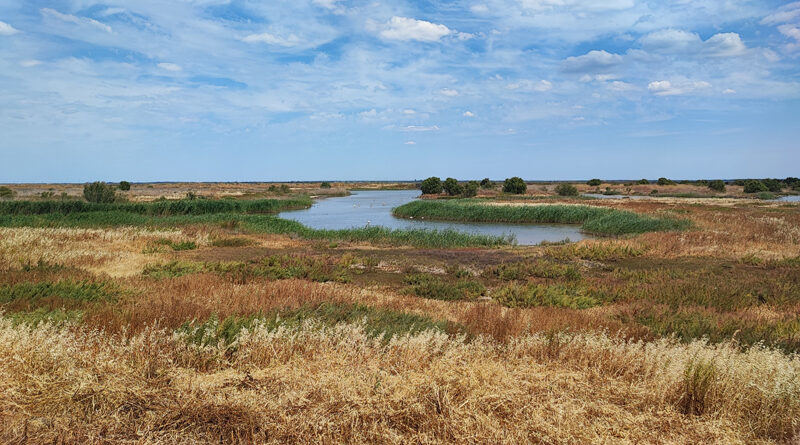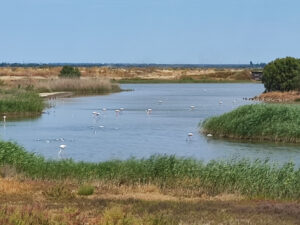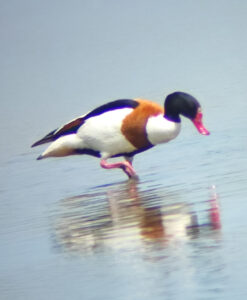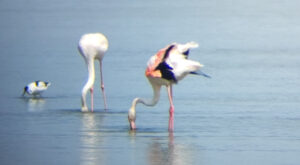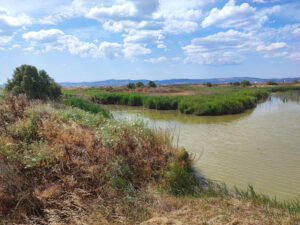EVOA, PORTUGAL – A WETLAND OF INTERNATIONAL IMPORTANCE
At first glance EVOA (Espaço de Visitação e Observação de Aves), just 30 minutes from Lisbon on the Tagus Estuary, is a beautiful wetland area with a wide range of bird species to see, well placed hides and a nice café. Think RSPB Rainham Marshes but with much better weather! A great day bird watching and strolling along the paths between the tall grasses rounded off with a light lunch and cake and coffee. And if that’s all you want, then you won’t be disappointed.
But if you take a moment to look a little closer, you might be surprised at what you discover.
EVOA is part of Companhia das Lezirias, a huge government owned farm that produces a wide range of products from cork, olives and beef, to pine wood, wine, and rice.
Yes, its aim is to make a profit, but they want to do it by working with nature and showing that yields can still be high when nature is considered too. I hear people say that a lot, so is this just another form of greenwashing? Well, at Companhia das Leziarias it is very clear that nature takes centre stage, even if it means reducing yields in the short term. Rather than focus on today they look at tomorrow. And EVOA is part of that.
Although other parts of Companhia das Lezirias grows crops and makes money, the company set aside large parts of the wetland specifically for the birds. Rice fields are still close by, but in this 70 hectare reserve, the birds are the priority.
This wetland nature reserve is an essential stop off for migrating birds. As they head south it is the last stop before a long ocean crossing, and going north it’s the first place to refuel again. Without this wetland refuge, many birds simply wouldn’t make it. And that would have a huge impact on bird populations across Europe and Africa, so it is an area that needs to be protected.
But Companhia das Lezirias isn’t just an area set aside for the birds, it also provides a buffer zone helping to protect crops in the lands to the north. In addition, EVOA is looking at ways to reduce conflict between farmers and birds. The aim is to find win-win solutions that work for the farmers but also help maintain or better still, increase bird populations. One example is the Collared Pratincole. This bird’s numbers had been decreasing considerably and conservationists were worried about its future in the area. So, land was specifically set aside to encourage the birds to nest here, in the hopes that the local populations could be rebuilt. It’s taken time, but the numbers are on the up, and the farmers aren’t suffering. So, a solid solution for all involved.
There are many examples like this around Companhia das Lezirias, from green corridors to carefully timed felling of trees – with every action, nature is part of the equation.
This is part of what makes EVOA such a great place to visit. Its beautiful, it’s full of birds and you know it is helping to make a real difference.
When visiting, allow some time to pop into the eco-friendly visitor centre. It is wholly off grid, solar powered, with its own water treatment facility, and an electric ‘bus’ to ferry visitors around. In the café they serve light lunches and salads. My guide, and passionate birder, Sandra Paiva, explained that some of the wetland plants are edible and often included in the salads they serve. I was unconvinced, so to prove her point Sandra picked Marsh Samphire (Salicornia europaea), Perennial Glasswort (Sarcocornia perennis), and Sea Purslane (Halimione portucaloides). These may look like unappetising ‘weeds’, but lightly cooked in olive oil, or sprinkled fresh on a salad they add a natural saltiness that brings out the flavour of your food. After my lunch I was a convert!
The centre also has a useful exhibition that explains the area, it’s inhabitants and why this reserve is so important. Education is a large part of EVOA’s work; teaching locals and visitors alike about the birds, why they need protecting and their importance in our future survival. Experts, like Sandra are on hand to answer questions, and identify bird species, so even if you can’t tell your mallard from your moorhen, don’t worry, they are happy to help. I’d recommend bringing your own binoculars but if that isn’t possible then there are scopes in the café, and by booking a tour you’ll get to use the equipment your guide will helpfully carry around.
If you intend to stay a few days in the local area (and I recommend you do) then the Lodges at Companhia das Lezirias are close-by and allow you to stay connected with nature in a tranquil, relaxed setting.
When is the best time of year to visit EVOA? The answer is; anytime. The area changes with the seasons and the birds you’ll see change with it. So, there is always something new to experience, no matter when you choose to land.
As Sandra explained as we sat in a hide, looking at the beautiful views and watching the birds, we all depend on nature and we need to ensure that nature has a home. We can’t keep taking away that home and expect our ecosystem to continue as normal. If we, the human race, is to have a future then we need to find a way to work with nature not against it.
So, a visit to EVOA is much more than a day spent in beautiful surroundings with some amazing birds, it is a lesson in sustainability, in the importance of finding ways to help nature and a reminder that we cannot always be on the take.
FACT BOX
Companhia das Lezirias – cl.pt
EVOA – evoa.pt
 ABOUT THE AUTHOR
ABOUT THE AUTHOR
Chantal Cooke is an award-winning journalist and broadcaster and co-founder of PASSION for the PLANET.
Chantal is passionate about tourism being used as a force for good. You can follow her adventures on Facebook and Twitter @chantalcooke and on Instagram @Chantaldcooke

